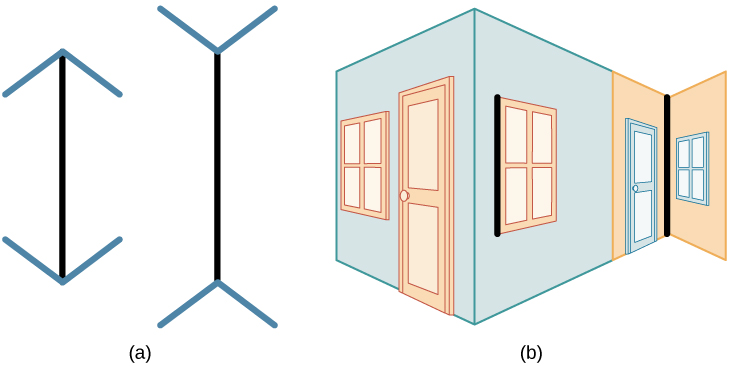Chapter 5. Sensation and Perception
SP.3: Deep Dive – Beliefs, Values, Prejudices, Expectations, and Life Experiences Affect Perceptions
Approximate reading time: 4 minutes
Our perceptions can also be affected by our beliefs, values, prejudices, expectations, and life experiences (Balcetis, 2016; Fawcett, Wang, & Birch, 2005). As you will see later in this chapter, individuals who are deprived of the experience of binocular vision during critical periods of development have trouble perceiving depth (Fawcett, Wang, & Birch, 2005; Gilaie-Dotan, 2015). The shared experiences of people within a given cultural context can have pronounced effects on perception (Kitayama, Markus, & Kurokawa, 2020). For example, a multinational study demonstrated that individuals from Western cultures were more prone to experience certain types of visual illusions than individuals from non-Western cultures, and vice versa (Halterman & DeLucia, 2021; Segall, Campbell, and Herskovits, 1963). One such illusion that Westerners were more likely to experience was the Müller-Lyer illusion (Figure SUP SP.3): The lines appear to be different lengths, but they are actually the same length (Gomez, Skiba, & Snow, 2017).
Two vertical lines are shown on the left in (a). They each have V–shaped brackets on their ends, but one line has the brackets angled toward its center, and the other has the brackets angled away from its center. The lines are the same length, but the second line appears longer due to the orientation of the brackets on its endpoints. To the right of these lines is a two-dimensional drawing of walls meeting at 90-degree angles.
Within this drawing are 2 lines which are the same length, but appear different lengths. Because one line is bordering a window on a wall that has the appearance of being farther away from the perspective of the viewer, it appears shorter than the other line which marks the 90 degree angle where the facing wall appears closer to the viewer’s perspective point

These perceptual differences were consistent with differences in the types of environmental features experienced on a regular basis by people in a given cultural context. People in communities that construct buildings using linear wood and metal often perceive their environment through a lens of straight lines. This phenomenon is referred to as a “carpentered world” in a study by Segall et al. (1966). In these communities, the architectural context is dominated by buildings with straight edges and angles.
On the other hand, communities that prefer non-linear constructions offer a different perceptual context. An example is the Zulu communities in South Africa. They are known for their villages composed of round buildings arranged in circles. According to Segall et al. (1999), individuals from such communities with an “uncarpentered” view are less susceptible to certain optical illusions that rely on straight-line perception.
This contrast highlights how cultural and environmental contexts can shape our perceptual experiences. It is not just vision that is affected by cultural factors. Indeed, research has demonstrated that the ability to identify an odour and rate its pleasantness and its intensity varies cross-culturally (Ayabe-Kanamura, Saito, Distel, Martínez-Gómez, & Hudson, 1998).
Image Attributions
Figure SUP SP.3 Figure 5.4 as found in Psychology 2e by OpenStax is licensed under a CC BY 4.0 License.
To calculate this time, we used a reading speed of 150 words per minute and then added extra time to account for images and videos. This is just to give you a rough idea of the length of the chapter section. How long it will take you to engage with this chapter will vary greatly depending on all sorts of things (the complexity of the content, your ability to focus, etc).

